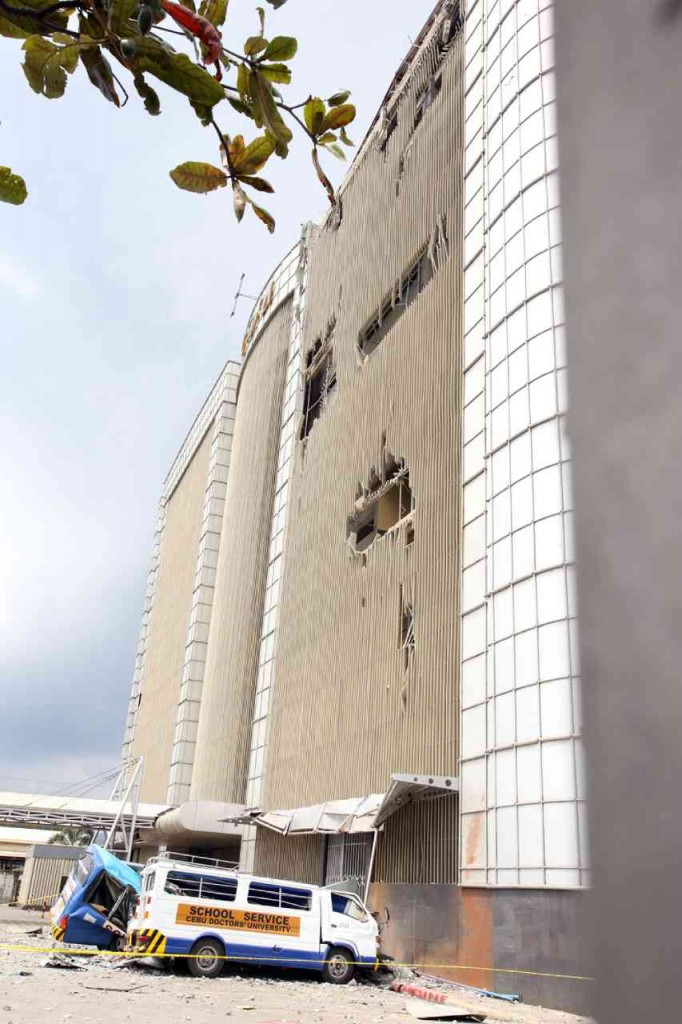
SECTIONS of the Cebu Doctors University building were damaged during an intensity 7 earthquake which hit Cebu and other parts of the Visayas.JUNJIE MENDOZA/ Cebu Daily News
On November 7 and 8, “Yolanda” (international name “Haiyan”), the strongest typhoon ever recorded to make landfall, plowed through the Central Visayas provinces, leveling nearly everything in its destructive path.
On October 15, a 7.2-magnitude earthquake hit the Central Visayas region, damaging centuries-old structures in Bohol province.
These two natural calamities highlight a pressing need in the Philippines for sturdier healthcare infrastructure.
More resilient
“We should be designing our hospitals to be more resilient in the face of such natural disasters, especially disasters relating to rising sea levels. We can have hospitals that store and extract energy at the roof, as opposed to placing them at the basement. There are also certain materials that you can design and build hospitals with so they would more likely withstand earthquakes,” explained Gary Cohen, Health Care Without Harm president and founder.
On the day of the earthquake, INQUIRER.net reported that the fifth floor of the Cebu Doctors University Hospital caught fire, while another section of the hospital collapsed due to the earthquake.
A video posted online showed nurses, students and patients standing in front of the building.
During the conference on “green hospitals” at the Cocoon Boutique Hotel in Quezon City on Oct. 15, Cohen met with hospital management, medical organizations and other institutions that have been championing the climate-change issue. Also present were representatives from Taiwan, Nepal, South Korea and Thailand, joining Dr. Nasir Hassan, World Health Organization-Western Pacific’s Environmental Health team leader.
Cohen has been an advocate and pioneer in environmental health for the past 30 years, and was recently named Champion of Change in the category of Climate and Health by US President Barack Obama.
Earthquake-proof
Cohen shared that in California, all hospitals had to be retrofitted to be earthquake-proof.
CEBU Doctors University hospital patients transfer to safer ground when fire broke out after the earthquake. JUNJIE MENDOZA /Cebu Daily News
“That might be something that can be done here. For the waste issue, we can use alternative technologies to address waste from emergency relief,” he added. When an institution reduces waste, it doesn’t have to spend so much to address the infectious waste, Cohen explained. “If you have less of the (infectious) waste, if you can segregate and recycle some of the waste, you can save money, because you have less waste to dispose of.
“Sometimes, if you design a new hospital that’s greener, it might cost more, but you immediately start saving money because it’s more energy-efficient. It’s using better materials because there’s positive impact,” he said.
Meanwhile, Cohen met with Senator Loren Legarda during his Philippine visit.
Legarda, in an Inquirer commentary published Jan. 25, 2010, said that her proposal was for the government to make all schools, as well as hospitals earthquake-proof.
“We must immediately conduct a nationwide structural evaluation of all schools and hospitals. We should retrofit these structures to allow them to withstand strong earthquakes,” she said.
Failure of construction
Legarda cited in the same commentary that experts are one in saying that failure of construction can be due to the following factors: inappropriate siting; inadequate design and materials specification; buildings constructed before enactment of current regulations; earthquake intensity in excess of level addressed by codes.
Other factors are inadequate building codes and regulations; codes and regulations not applied; unauthorized omissions or substitutions on site during construction; absence of, inadequate or dilatory construction inspection; construction in rural areas being less likely to be inspected; and reuse of building components from buildings previously demolished.
In an Inquirer report Nov. 14, the Philippine Children’s Medical Center announced it would be accepting a limited number of patients until February or March next year to give way to repairs to strengthen the structural integrity of the over 30-year-old hospital.
The report said that the hospital started retrofitting earlier this month, the first major renovation since its inauguration in 1980. Seismic retrofitting strengthens older buildings to make them resistant to earthquakes.